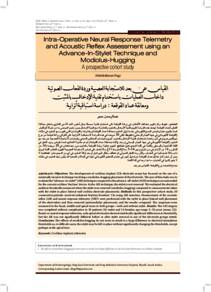وثيقة
Intra-operative neural response telemetry and acoustic reflex assessment using an advance-In-stylet technique and modiolus-hugging : a prospective cohort study.
عناوين أخرى
القياس عن بعد للاستجابة العصبية وردة الفعل الصوتية داخل العمليات باستخدام تقنية الادخال المثبت ومعانقة عماد القوقعة: دراسة استباقية أترابية.
الناشر
College of Medicine, Sultan Qaboos University.
ميلادي
2011-08
اللغة
الأنجليزية
الموضوع
الملخص الإنجليزي
The development of cochlear implant (CI) electrode arrays has focused on the use of a minimally invasive technique involving a modiolus-hugging placement of the electrode. The aim of this study was to evaluate the "advance-in-stylet" (AIS) technique compared to the advance-off-stylet (AOS) technique recommended for the current cochlear Nucleus® device. In the AIS technique, the stylet is not removed. We evaluated the electrical auditory thresholds measured when the stylet was removed (modiolus-hugging) compared to measurements taken with the stylet in place (lateral wall cochlea electrode placement). Methods: In this prospective cohort study, 30 consecutive patients received unilateral Nucleus Freedom® CIs using AIS insertion. Measurement of the acoustic reflex (AR) and neural response telemetry (NRT) were performed with the stylet in place (lateral wall placement of the electrodes) and then removed (perimodiolar placement), and the results compared. The responses were measured in the basal, middle and apical turns in both groups—with and without stylet. Results: The AIS surgery was completed without complication in 30 patients (16 males and 14 females, age range 3-54 years [mean 11]). Based on neural response telemetry, only apical electrodes showed statistically significant differences in thresholds, but the AR was not significantly different before or after stylet removal in any of the electrode groups tested. Conclusions: The effects of modiolus-hugging do not seem to result in a large difference in electrical stimulation thresholds so, in difficult cases, the stylet may be left in place without significantly changing the thresholds, except perhaps at the apical turn.
المجموعة
URL المصدر
zcustom_txt_2
Hagr, Abdulrahman (2011). Intra-Operative Neural Response Telemetry and Acoustic Reflex Assessment using an Advance-In-Stylet Technique and Modiolus-Hugging : A prospective cohort study . Sultan Qaboos University Medical Journal, 11, ( 3) 377-369.
الملخص العربي
ركز تطوير مصفوفات أقطاب غرسة القوقعة الصناعية (CI) على استخدام تقنية طفيفة التوغل تتضمن وضع القطب الكهربي بطريقة احتضان موديول. كان الهدف من هذه الدراسة هو تقييم تقنية "التقدم في التصميم" (AIS) مقارنةً بتقنية (AOS) المتقدمة الموصى بها لجهاز Cochlear Nucleus® الحالي. في تقنية AIS ، لا تتم إزالة النمط. قمنا بتقييم العتبات السمعية الكهربائية التي تم قياسها عند إزالة التصميم (تعانق الموديول) مقارنة بالقياسات التي تم إجراؤها مع وجود القوقعة في مكانها (وضع قطب القوقعة الجانبي للجدار). الطريقة: في هذه الدراسة الأترابية المرتقبة ، تلقى 30 مريضًا متتاليًا أجهزة Nucleus Freedom® CI أحادية الجانب باستخدام إدخال AIS. تم إجراء قياس المنعكس الصوتي (AR) والقياس عن بُعد للاستجابة العصبية (NRT) مع وجود القصاصة في مكانها (وضع الجدار الجانبي للأقطاب الكهربائية) ثم إزالتها (وضع محيط القطب) ، ومقارنة النتائج. تم قياس الاستجابات في المنعطفات القاعدية والوسطى والقمية في كلا المجموعتين - مع أو بدون نمط. النتائج: تم الانتهاء من جراحة AIS بدون مضاعفات في 30 مريضاً (16 ذكراً و 14 أنثى ، الفئة العمرية 3-54 سنة [يعني 11]). استنادًا إلى القياس عن بعد للاستجابة العصبية ، أظهرت الأقطاب القمية فقط اختلافات ذات دلالة إحصائية في العتبات ، لكن AR لم يكن مختلفًا بشكل كبير قبل أو بعد إزالة الأنبوب في أي من مجموعات الأقطاب الكهربائية التي تم اختبارها. الاستنتاجات: لا يبدو أن تأثيرات احتضان الموديول تؤدي إلى اختلاف كبير في عتبات التحفيز الكهربائي ، لذلك ، في الحالات الصعبة ، يمكن ترك النمط في مكانه دون تغيير العتبات بشكل كبير ، باستثناء ربما عند المنعطف القمي.
قالب العنصر
مقالات الدوريات

